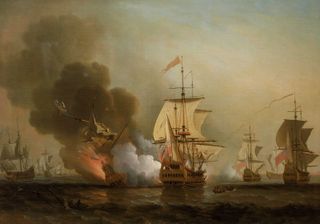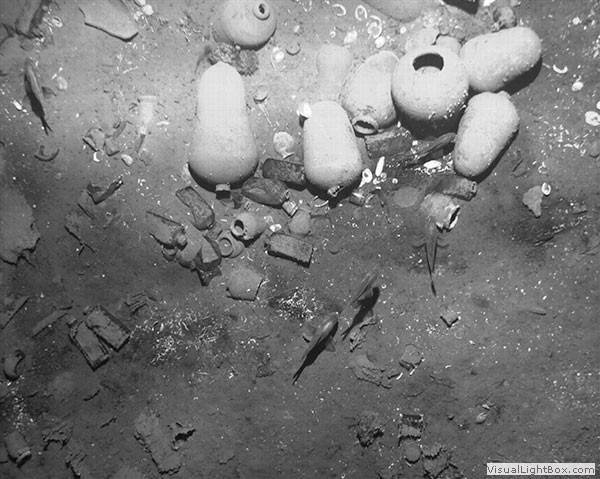How To Explore Sunken Ships In Minecraft
Sunken Treasure Send Worth Billions Maybe Found After 300 Years

The wreck of a lost treasure transport has been found 307 years afterwards information technology vanished beneath the waves.
The galleon San Jose was found at the bottom of the Caribbean off the Colombian coast on Nov. 27, President Juan Manuel Santos of Colombia said in a statement on Sabbatum (Dec. 5). Built in 1696, the Spanish galleon was lost in a ocean boxing with the English in 1708.
A mod battle seems likely to erupt over the notice. As CNN and other outlets reported, a U.S. salvage firm has claimed that it originally discovered the site of the wreck in 1981 and is owed half the treasure on the ship — a booty of gold and silver from South America thought to be worth between $4 billion and $17 billion. [See Photos of the 'San Jose' Treasure Ship and Artifacts]
The Colombian regime has not released the precise location of the wreck, nor much information virtually the discovery process.
"While this is an extremely exciting find, I'm anxious to run into more of the archaeological prove and what characteristics of the shipwreck were used to come up with the identification," Frederick "Fritz" Hanselmann, an underwater archaeologist at Texas Land University who studies shipwreck sites, told Live Science.
The San Jose was a 1,066-ton behemoth of a transport, which was equipped with sixty cannons and held a stash of gold and silver coins and emeralds from the mines of Republic of peru. This treasure was ultimately headed to Europe, where it would fuel the long-running War of Spanish Succession, a conflict that pitted the Spanish and French against the English.
According to a history of the San Jose (opens in new tab) introduced into the court proceedings between the Colombian government and the salvage business firm claiming role ownership of the wreck, the San Jose held a particularly huge haul of treasure. Earlier in the war, Castilian armadas had escorted treasure ships dorsum to Europe annually. Only afterwards the English armada ambushed an fleet in northern Spain and wiped it out, small-scale French warships took over the responsibleness of moving gold, argent and precious gems in smaller loads across the Atlantic Ocean.

The San Jose was function of the first fleet to undertake the Atlantic crossing in half-dozen years. The Rex of France, Louis XIV, needed the treasure to fund the war, and ordered a French armada to accompany the San Jose and 3 other galleons across the ocean. (In add-on, 11 smaller Spanish ships guarded these four huge warships.)
Ultimately, all the same, the French escorts were delayed, and the commander of the Spanish fleet, Admiral Jose Fernandez de Santillan, Count of Casa Alegre, decided to go it alone. [Shipwrecks Gallery: Secrets of the Deep]
With more than than 500 men crewing the ship, the San Jose set sail on its last voyage on May 28, 1708, carrying a total one-half of the treasure. The armada was headed for Cartagena, Colombia, en route to Havana so Europe, just ran into iv English language ships allowable by Commodore Charles Wager.
Unable to outrun the English language, Alegre and his armada reluctantly prepared to fight. A cannon battle ensued; equally outlined in the court history, the decks of both Wager's warship and the San Jose grew slick with blood, and the crews of both ships threw down sand to improve the footing on deck.
Suddenly, the San Jose erupted into a fiery conflagration and sank. Accounts vary on whether this was due to an explosion of the transport's powder room or a structural collapse and fire that were caused by the British bombardment. (The ship was already leaking and had a compromised hull considering of damage by rot and worms.). According to the Colombian regime, an archaeological study of the wreck could answer this question.
Well-nigh 600 men died when the San Jose went down, including Admiral Alegre. The court history recalls the tragedy:
"Six hundred lives had been destroyed in an instant. Almost of them, including Alegre, either were vaporized in the explosion or went to the bottom of the Caribbean with the tons of precious metallic which had been destined to finance the killing of thousands more than on the battlefields of Europe."
According to the office of the Colombian president, archaeologists identified the shipwreck of the San Jose with certainty by its cannons. The discovery was managed by the Colombian Ministry of Civilization and the Colombian Establish of Anthropology and History, as well every bit by "international experts," whom the government declined to place. Perhaps because of the assumed value of the treasure onboard, the government also refused to pinpoint the resting spot of the wreck, other than to say that it was found in a location non previously identified as the site of the San Jose.
The U.South. firm Sea Search Armada claimed to take constitute the San Jose in 1981, a claim that has led to a long legal battle between the salvage group and the Colombian regime. The Colombian authorities claims that the Colombian court system has found that information technology does non have to split the treasure with Sea Search Armada; however, in a statement to CNN, Body of water Search Armada argued that the matter remains undecided.
According to The Guardian newspaper, there may be another claimant waiting in the wings: Spain is weighing action to reclaim its "sunken wealth."
The exploration teams used sonar and an autonomous underwater vehicle to find the send. Parts of the original construction are visible on the body of water floor, according to the president's office, along with ballast, statuary cannons, ceramics, porcelain vases and weapons.
Information technology's these humble items that excite archaeologists more than silver and aureate. The positions and use of armed forces and galley items can reveal a great deal about how sailors employed by the far-flung Spanish empire lived their daily lives, said Justin Leidwanger, a professor of classics at Stanford University who studies Mediterranean shipwrecks and ports.
"From a history of technology standpoint, it could exist huge for telling us a scrap more most how Espana was able to hold on to a global empire," Leidwanger told Live Science.
Editor'southward note: This article was updated on December. 9 at 12:xxx p.1000. ET to add quotes from archaeologists Hanselmann and Leidwanger.
Follow Stephanie Pappas on Twitter a nd Google+ . Follow us @livescience , Facebook & Google+ . Original article on Alive Science.
How To Explore Sunken Ships In Minecraft,
Source: https://www.livescience.com/53027-sunken-treasure-ship-found.html
Posted by: perkinsamor1939.blogspot.com


0 Response to "How To Explore Sunken Ships In Minecraft"
Post a Comment